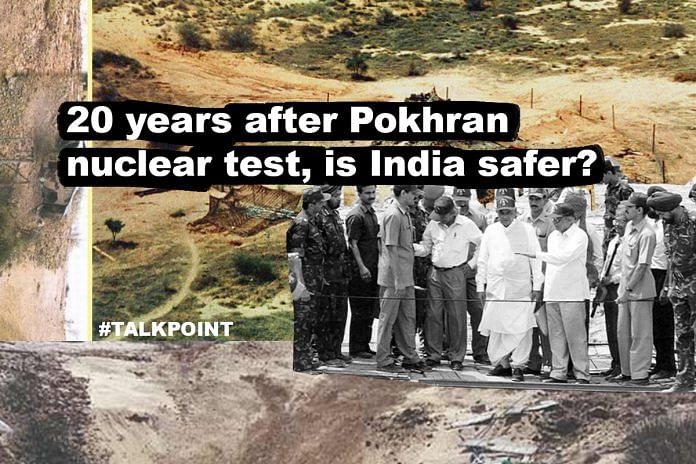On 11 May, 1998 the Atal Bihari Vajpayee government successfully conducted surprise nuclear tests in Pokhran, Rajasthan. Though it was the second nuclear test to be conducted it officially made India a nuclear weapons state.
ThePrint asks: 20 years after Pokhran nuclear test, is India safer?
India now seen globally as a ‘responsible’ nuclear weapons state
 AVM Arjun Subramaniam (retd)
AVM Arjun Subramaniam (retd)
Retired Air Vice Marshal from the IAF, currently a Visiting Fellow at Oxford University
Nuclear weapons have been an acknowledged currency of power in a post-WW II era that was heralded using two of these weapons. Nuclear deterrence formed the core of the Cold War rivalry between the two superpowers and the race to acquire limited nuclear weapons lay at the heart of numerous rivalries– India-China, India-Pakistan, Israel-Iran-Arab States, North Korea-South Korea being a few of them.
In my view, the acquisition of a modest arsenal of nuclear weapons that has grown in capability and reach has made India stronger in terms of state power. It also heralded the transition of India from being a diffident power with idealistic aspirations of a liberal world order that is devoid of nuclear weapons, to a power of consequence that understands the dynamics of a ‘realist’ world order.
The collapse of the Soviet Union and dynamic changes in the nature and character of war has seen India emerge none the safer despite possessing nuclear weapons. It has been seriously tested by adversaries who are adept at ‘waging war’ and managing the escalation ladder to stay well below India’s nuclear threshold levels.
However, decades after the ‘Buddha Smiled’, India can be reasonably sanguine that it is now seen as a ‘responsible’ nuclear weapons state with all the characteristics to support a place at the high table as a power of consequence and much potential.
Once India & Pakistan became nuclear, full scale wars in the subcontinent became passé
 Lt. Gen. HS Panag (Retd)
Lt. Gen. HS Panag (Retd)
Former GOC-in-C, Northern & Central commands
India has never faced an existential threat since Independence that would’ve forced early development of nuclear weapons as in the case of Israel. The ‘big four’ did not pose any threat to us so our focus remained on conventional deterrents.
However, the humiliation of 1962 was worse than a decisive defeat. In two months, we lost our military reputation and international prestige. Our Peaceful Nuclear Explosion (PNE) in 1974 was a response to this and the 1963 Chinese nuclear tests.
India cleverly chose the term ‘PNE’ to avoid sanctions and to continue occupying the moral high ground on disarmament. Like Israel, we could have relied upon cold tests and retained an ambiguous nuclear strategy. This would have deterred China and restrained Pakistan from openly developing nuclear weapons and allowing our decisive conventional superiority to prevail in the event of a war. Even when Pakistan secretly developed and cold tested its nuclear bomb in the 1980s, the unreliability of the weapon and untested delivery means would have ensured that we could achieve decisive results before a threat developed. This was the situation until 1999.
Once India and Pakistan, like China, became overtly nuclear, it became clear that full-scale wars in the subcontinent are passé. Nations armed with nuclear weapons do not, and I dare say, cannot fight decisive conventional wars of annihilation to achieve political aims. Yet the entire spectrum of conflict below the nuclear threshold can continue to be exploited to achieve political and military aims. Nuclear weapons have given virtual immunity to Pakistan to perpetrate a Fourth Generation War (4GW) in J&K and the hinterland of India. It quickly developed the delivery means and even tactical nuclear weapons, laid down its ‘nuclear thresholds’ and without fighting, neutralised our conventional superiority while continuing to pursue its strategy with 4GW. China cannot repeat 1962, but continues to embarrass us on the line of actual control.
From Smiling Buddha to Operation Shakti, how India’s power trajectory gradually unfolded
 Seshadri Chari
Seshadri Chari
Security and strategic affairs commentator, former editor, Organiser
Thirty years after Homi Jehangir Bhabha presented his suggestions on harnessing nuclear energy, Indira Gandhi approved conducting of the first nuclear test on 18 May 1974, codenamed ‘Smiling Buddha’. Twenty-four years later, five detonations (one fusion and four fission) carried out on 11-13 May 1998, codenamed Operation Shakti marked India’s entry into the full-fledged nuclear countries’ club.
After the 1974 tests, the Nuclear Suppliers Group imposed a technological embargo on India leading to research and further nuclear programmes being slowed down. But continued perseverance of scientists and political willpower resulted in Pokhran-2, widely welcomed by the people and the market but strongly condemned by US, China, Japan and the then Congress leadership.
The NDA government led by Vajpayee overcame the effects of sanctions and even repaid the nearly forty-four billion dollar loan to international lending institutions. The futility of punitive actions dawned upon the US administration and after a series of failed attempts to coerce India to sign the Comprehensive Nuclear-Test-Ban Treaty or roll back the nuclear programme, the US began negotiations for a new strategic relationship with New Delhi.
Twenty years after Pokhran-2, India is dealing with the US, China, Japan and other global institutions from a position of strength. Our nuclear technology is inching towards being world class and so is our safety standards and commitment to disarmament.
From Smiling Buddha to Operation Shakti, it is a gradual unfolding of India’s power trajectory and growth agenda.
The notion that nuclear capability brings deterrence is a flawed idea
 Lt Gen. Syed Ata Hasnain (Retd)
Lt Gen. Syed Ata Hasnain (Retd)
Former GOC of Srinagar-based 15 Corps, associated with the Vivekananda International Foundation and the Institute of Peace and Conflict Studies
The notion that overt nuclear weapon capability by itself provides security through deterrence is essentially a flawed idea. Security through nuclear weapon capability at a point in time is good only for that time and a little beyond. What is needed is a progressive development of linked capabilities such as delivery systems, surveillance (eye in the sky), guidance, command, control infrastructure, doctrine, strategy and ability to stay the course to prevent adversaries closing the gap.
While India has achieved much in the field of nuclear capability, it is the deterrence effect which will always remain in question. Against Pakistan, the below-threshold deterrence has not worked as that country employs sub-conventional methods against us with impunity. In addition, by developing tactical nuclear weapons (TNWs) and adroitly using the spin connected with their capability, Pakistan has stymied India’s conventional warfare thinking to some extent.
With China, our prime reason for going nuclear, the capability gap appears yawning. Although strike capability against counter value targets in China’s heartland (the east coast) may have been achieved, the numbers do not yet inspire confidence. More importantly, we appear far from subsurface second strike capability which in the current circumstances acts as a greater deterrent.
What India has definitely achieved is a higher indigenous scientific capability (including space) which augurs well for the future provided it keeps pace with the developments by the adversaries. Understandably, nuclear weapons are not for warfighting. Therefore the spin connected to them in strategic and doctrinal terms must now receive as much attention as the physical capability. Smaller numbers can achieve much, provided their threat of usage always appears realistic.
Nuclear weapons haven’t given India a day-to-day sense of security, but a sense of ‘existential security’
 Happymon Jacob
Happymon Jacob
Associate Professor of Disarmament Studies , JNU, founder of online archive called Indo-Pak Conflict Monitor
Nuclear weapons have contributed to creating more stability in the south Asian sub-system that is inhabited by India and two other nuclear weapon states. Nuclear weapons do not, and have not, offered India a day-to-day sense of security, but they have provided the country with what could be referred to as ‘existential security’. Put differently it works as a guarantee for national survival.
If India had not developed nuclear weapons, China would still have had nuclear weapons. There is no guarantee that Pakistan would not have developed nuclear weapons if India were to renounce the nuclear option. In any case, given the strong strategic partnership between China and Pakistan, India would have been insecure in the deeply unstable southern Asian neighbourhood. The American withdrawal from the region and the rise of China would have further contributed to India’s regional security concerns.
On the other hand, nuclear weapons have also created a regional environment in which lower level instability has become a lot more prominent. While the (limited) Kargil war of 1999 was fought under nuclear conditions, it is also true that Pakistan’s nuclear weapons and their low threshold prevented India from being able to respond to terror strikes in 2001 and 2008. In that sense, nuclear weapons can potentially increase sub-conventional attacks (read terrorist attacks) and lower level instability. More so, the arrival of nuclear weapons has also triggered a strategic arms race between India and Pakistan (i.e. investments in anti-ballistic missile defence, tactical nuclear weapons, space-based assets etc.).
In short, then, I would argue that nuclear weapons have provided India with a sense of existential security and confidence to deal with the international system even though they have contributed to creating conditions for more unconventional attacks against the country.
India’s relationship with other nuclear powers has enhanced since Pokhran
 Arun K. Singh
Arun K. Singh
Former ambassador to United States of America
India is certainly strategically more secure today, and its global standing and relevance enhanced, than it would be without a demonstrated nuclear weapons capability. This is reflected in its subsequent relationships with other nuclear weapon powers.
France entered into a strategic partnership with India after the Pokhran tests in 1998. Cooperation in defence, space and nuclear energy were taken forward. The two issued a Joint Strategic Vision of Cooperation in the Indian Ocean on 10 March this year, during President Macron’s visit. They also signed an agreement for the provision of reciprocal logistics support between their armed forces.
The US after initial criticism and sanctions, entered into a civil nuclear cooperation agreement with India enabling across the board erasure of technology restrictions. It articulated support for India’s permanent membership of the UN Security Council, declared India a Major Defence Partner, and allowed force multiplier defence supplies. In 2015 the two issued a Joint Strategic Vision for Asia Pacific and Indian Ocean Region.
Relations with Russia, too, were consolidated further. The UK is looking at India as a major pole as it seeks to define global post-Brexit Britain.
The equation with China continues to be marked by competition and cooperation. Our nuclear capability gives India assurance in light of China’s growing economic and conventional military strength, and nearly five-fold disparity.
Pakistan continues with its asymmetric challenge, through terrorism, but it had signalled the capability to build a device way back in 1987 and was not motivated by the Indian tests.
Other nuclear powers also face sub-conventional threats such as 9/11 in the US, homegrown and internationally linked terrorism in France, UK and Russia, and ETIM in China.
Compiled by Deeksha Bhardwaj, journalist at ThePrint.



